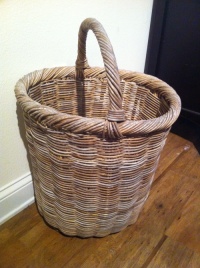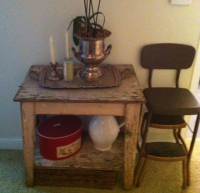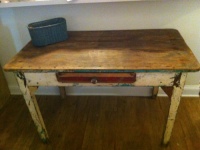 Recently I went to a swap meet (AKA flea market, open air market, etc.).
Recently I went to a swap meet (AKA flea market, open air market, etc.).
A friend of mine who is a rather savvy shopper met me there. I made off with a TON of goods for great prices and truly one-of-a-kind pieces that no one else will ever have.
Several hours, sunburned shoulders and a FIVE dollar cup of lemonade later, I was in a chipper mood, ready to take my leave and re-explore my newly found objects d’ art!

My friend, on the other hand, was deflated.
Later that night, I asked how she enjoyed herself. She told me she felt overwhelmed by everything, and even when she found something she liked she had a nagging suspicion she was being ripped off.
As a designer I am always mentally recording cost vs. quality. When I go to a swap meet, or any second-hand shopping, (my mother would refer to this as “junking”) I am armed with an extraordinary sense of a good deal. That is my job, my duty to the client.
I realized that some basic guidelines would really help someone who is a new shopper, or an old shopper new to the swap meet game.
A table found on the side of the road becomes a great occasional table under a Papier Mache rhino head found at Anthropolgie.
A desk found at a swap meet doubles as a dining table in a small apartment.

2. When going to a swap meet for things you actually need, as opposed to pleasure browsing, ALWAYS make a list and bring it with you. I find the easiest way to do this is by making notes on my phone throughout the month. I add to it regularly and by the time my choice of swap meets rolls around I have a really good list!
3. Have measurements on hand (on your list is best). For example, if you need a side table, a couch, a head board, include the maximum and minimum amounts of space you have allocated to the piece of furniture.

5. The best people to buy from at a swap meet are those who are in the same place time and time again, even if they are a little higher priced than another guy – if you have an issue you know right where to find them and they tend to be very interested in making sure you come back again and again!
6. Haggle, dicker, wheel and deal, and join in all the other varying forms of asking for a better deal. Don’t be embarrassed about asking for a lower price. The people who are at a swap meet are fully cognizant that they aren’t Bloomingdale’s (although my husband has been known to haggle a better price even on 5th Avenue).
7. Don’t mistake a swap meet for a yard sale. It isn’t one. These are professionals who make their living selling merchandise that they have either purchased and are selling for a profit or have found and restored in some way. I say that because you cannot expect to pay a buck oh five for everything at a swap meet. Some of the spaces cost upwards of $200 for the day alone!
8. Finally, enjoy yourself, take in all the sights, people watch, and bring your own water and lemonade!!